Family Handyman Approved: Rise Personal Indoor Garden
To me, the best thing about gardening is simply being around growing things. Whether it’s plants, flowers, fruits or vegetables, I just love observing the small changes, the act of nurturing, and of course consuming food I’ve grown myself.
As a lifelong vegetarian, I always try to get my hands on the freshest vegetables possible during the cold winter months. I’ve even grown them indoors myself here and there with limited success.
As an editor here at Family Handyman, I love sharing with readers the latest trends and innovations in all the areas of the home we cover, including gardens. This is what led me to test an indoor garden, specifically a personal garden from Rise Gardens. I have to say that I was pretty impressed.
If you’ve been on Instagram lately, you know indoor gardens are trending. I attribute this bump mainly to people seeking ways to grow fresh produce indoors to help beat the winter blues and stay productive, since many of our go-to winter activities are not exactly viable in a pandemic world.
The act of gardening also provides truly farm-to-table produce, eliminating (or minimizing) the need for grocery store runs where the stuff you’re buying isn’t always easy to source. The convenience is huge. I love waking up each morning and seeing something fresh and fragrant growing right there in my kitchen.
What is the Personal Rise Garden?
Many manufacturers now make gardens of all sizes, designs and functionality. What drew me to Rise was the design. As much as I love vertical gardens, that’s not what I wanted in my small kitchen. I liked the simple, sleek, modern look Rise offers in all their gardens, including the personal garden I tried.
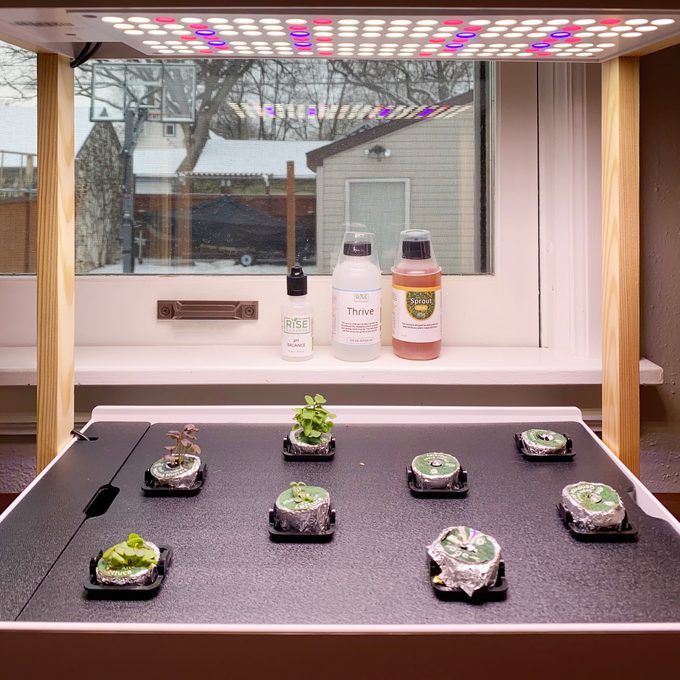
When I opened the box, I was surprised by how compact the personal garden was (18 inches long, weighing only 10 lbs.) and how easy it was to set up. Here’s what came in the box:
- The base;
- Grow lights;
- Water pump;
- Eight net cups;
- Garden nursery (for extra seeds and storage; I didn’t end up using mine);
- Eight seed pods:
- Parris Island Cos Lettuce;
- Bronze Arrowhead Lettuce;
- Astro Arugula;
- Red-Streaked Mizuna Mustard;
- Super Sweet Genovese Basil;
- Common Sage;
- Forest Green Parsley;
- Santo Cilantro.
- Six weeks worth of hydroponic nutrients (which you’ll have to add weekly):
- One starter-size bottle of Sprout;
- One starter-size bottle of Thrive;
- One starter-size bottle of pH Balance.
You can’t choose the veggies and herbs that come in the initial package, but what they provided worked for me. You can always order individual seed pods directly from the site if you want something different. There’s a wide variety to choose from, everything from microgreens to beets.
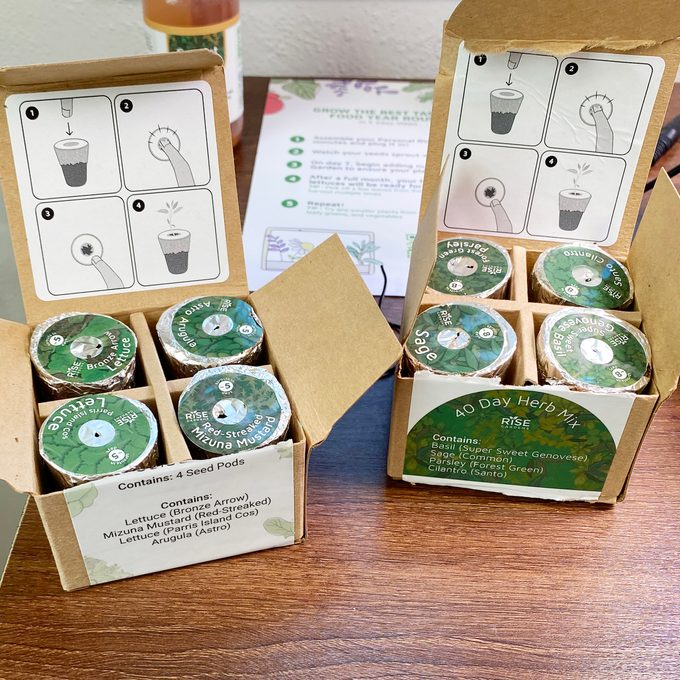
What is a Hydroponic Garden?
The Rise Personal Garden is a hydroponic garden, meaning it doesn’t use soil. It’s also considered by agriculturists to be one of the most eco-friendly gardening methods because it requires little water or space.
Since indoor hydroponic gardens are in a controlled environment, they can also produce much higher yields than more traditional gardening or farming methods. Key to hydroponic gardens are their use of a water pump and the manual addition of specific nutrients (included with the Rise Garden). These help supplement nutrients plants would normally be getting through the soil.
I’ve never had a hydroponic garden before and I admit to being a little intimidated by that aspect at first. How does it work? What if the pump breaks? What if the plants aren’t growing?
But once I opened the box and actually looked at what goes into the hydroponic component, I quickly realized that this was not only going to be easy, but a welcomed change. Not having to deal with soil or the fear of over-watering was a plus.
Ultimately, I feel like the hydroponic system is super slick. Once you wrap your head around the need to test the pH level in your tap water (using the kit provided by Rise) and manually add nutrients (Thrive, Sprout and pH Balance — all provided in your kit), it’s really pretty easy. And it provided me with a chance to teach my young kids some basics about hydroponic gardening.
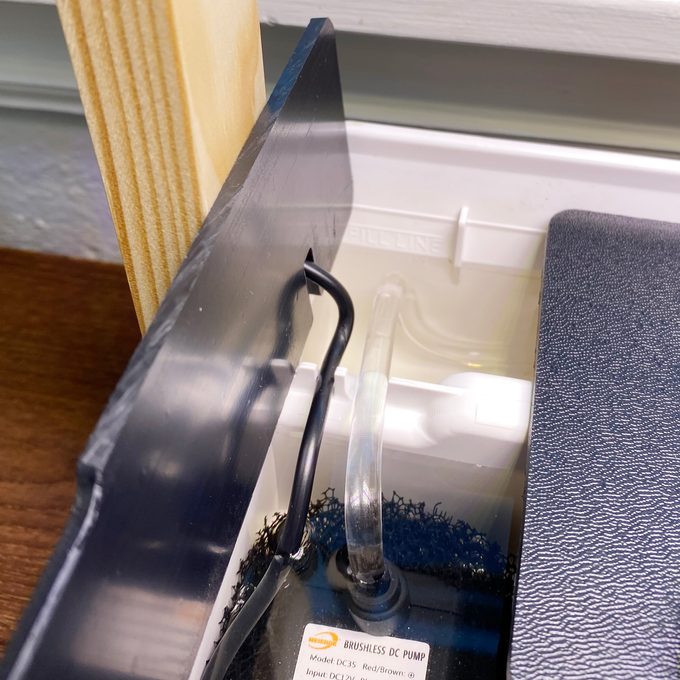
How I Tested It
I tested this product in my kitchen over six weeks. I wanted enough time to see if sprouts would develop from the Net Cups following the timeline Rise provides in the user guide. They did. Same with the harvest time for each individual plant. Those were spot on, too.
My Mizuna Mustard never really took off and grew much beyond a few inches, but in all fairness I can’t rule out user error. Maybe I didn’t place it firmly in the cup, or maybe it somehow got jostled in such a way that it wasn’t getting enough nutrients.
I feel like the environment in my home honestly qualifies as pushing the boundaries of the durability and sturdiness of this garden. We have three kids and two dogs and our kitchen sees a ton of foot traffic. The very next day after I set the garden up, my three-year-old reached in and grabbed the Sage, ripping it out of its cup and whipping it on the floor in that unexplainably aggressive way that toddlers do just about everything.
Luckily, I was salvaged the Sage and it ended up growing. The lesson? Make sure you place the garden high enough so kids or curious puppies can’t get to it, yet low enough so it’s easy for you to access every day.
Performance Review
Performance: I felt like this garden performed exactly like I wanted and expected, right down to the exact time to harvest the veggies. I was skeptical about this at first. I thought, well, there are all kinds of environmental elements that could affect the grow times and the bounties produced. But everything grew as expected.
Value: I think this garden provides the value most folks look for when purchasing a product like this. Now, I haven’t done the math to see if the average user would save money on fresh veggies or herbs by growing them at home in this garden that sells for $279, versus buying them regularly at a grocery store. But that’s a tricky thing to calculate given each user’s consumption habits and access to fresh produce. My gut tells me that this garden would be cost-saving over time.
Reliability and durability: Over six weeks, this garden proved to be durable and reliably produced veggies.
Ease of use: This was a snap to set up and use. True, the app and WiFi connectivity might feel overwhelming to some users. But if you feel generally comfortable with technology, this will be intuitive for you.
If you’re a person drawn to gardening solely for the experience of working in the soil, feeling the sunshine on your face or hearing the birds chirping, then you will likely be disappointed by this or any indoor garden. This garden provides some greenery in your home, true, but it mainly provides a means to an end — a way to have fresh veggies when temperatures fall into the single digits.
Aside from the indoor vs. outdoor gardening experience, I’d say the biggest variation has to be the app component. You can download the Rise Gardens app, create an account and connect your garden to your home’s WiFi. I had trouble with this at first because the garden wouldn’t work on our 5G network, so I had to choose a different network and it took me a few minutes to figure out the issue.
Note that you don’t need to connect to the internet to use the garden, but I could immediately see the benefits of connecting. I could get notifications on my phone when it was time to add nutrients or water. You can also control the lights and the water pump using the app.
You’ll see a few care lights on the front of the garden that alert you when it’s ready for care as well. And it also tells you when it’s time to harvest your veggies or herbs, based on what you are growing and when you planted them.
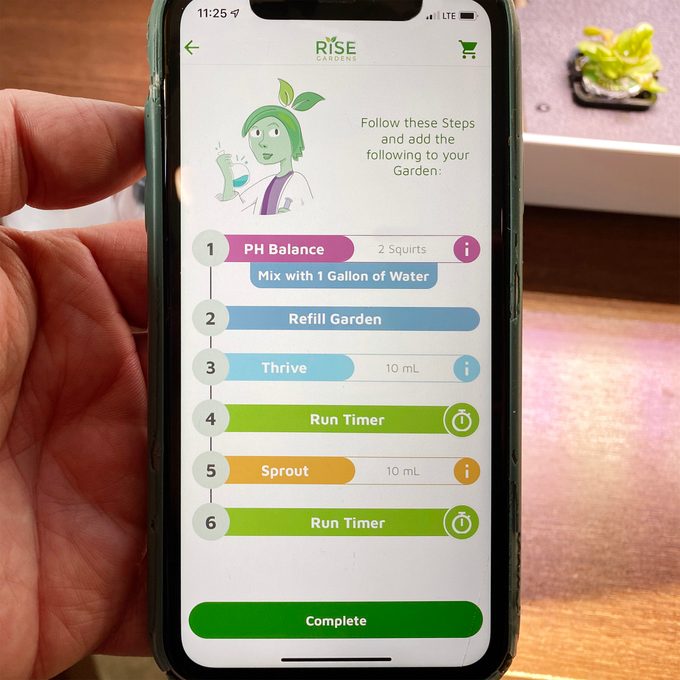
I think the biggest question to ask yourself before purchasing a garden like this is what you hope to get out of it. Are you expecting a superabundant yield where you’ll have constant access to fresh herbs and veggies? Because that’s not what you’ll get with the personal garden.
Rise also has other bigger garden options where you can assess how much space you have in your home, how much work or time you’re willing to commit and how much produce you’ll need. If I purchased this garden to truly serve fresh produce to my family of five consistently, I would definitely choose one of the bigger gardens.
Why You Should Buy This
If you’re a single person or someone who doesn’t eat a ton of fresh produce regularly, the personal garden is perfect for you. If you’re curious about how hydroponic gardens work and you want an introduction to these systems without a heavy time commitment or the desire to go “deep” on hydroponic gardening, this garden is also for you.
Here are some other pros and cons of this garden:
Pros:
- Compact size, lightweight and easy to move by yourself;
- No dirt or chemicals means no need to wash veggies ;
- No pests to control;
- Easy to set up;
- Access to fresh produce daily or weekly;
- It can be a visually appealing centerpiece of your kitchen.
Cons:
- Personal garden doesn’t yield enough even for one person if your diet primarily consists of produce (like my vegetarian diet does);
- Need reliable internet for full garden functionality.
Pro tip: Use the LED grow light panel that comes with the garden to provide light for other small plants, too. I tucked some succulents around the base of the garden to “share the love” and they’ve been thriving.
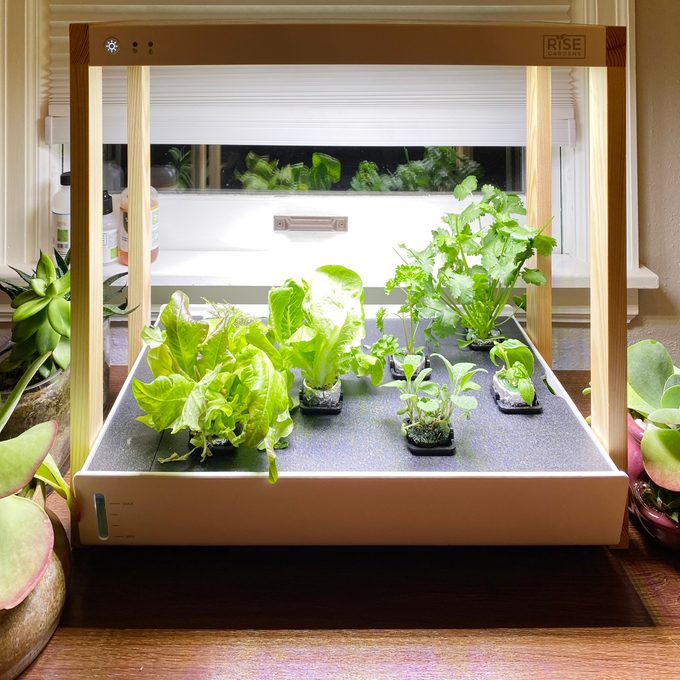
Where to Buy the Rise Personal Garden
You can buy this garden on Amazon or from Rise Gardens itself.
About the Author:
Amy Novak is Family Handyman’s Executive Editor, leading a talented team of digital editors in producing helpful home improvement projects, expert tips, stellar product recommendations and DIY inspiration. Working in digital media for nearly two decades, Amy loves sharing stories and useful information that empowers readers to build, renovate, clean or fix things themselves. When she’s not at work, Amy can usually be found consuming vegetables or tending to her expansive veggie garden.



No comments